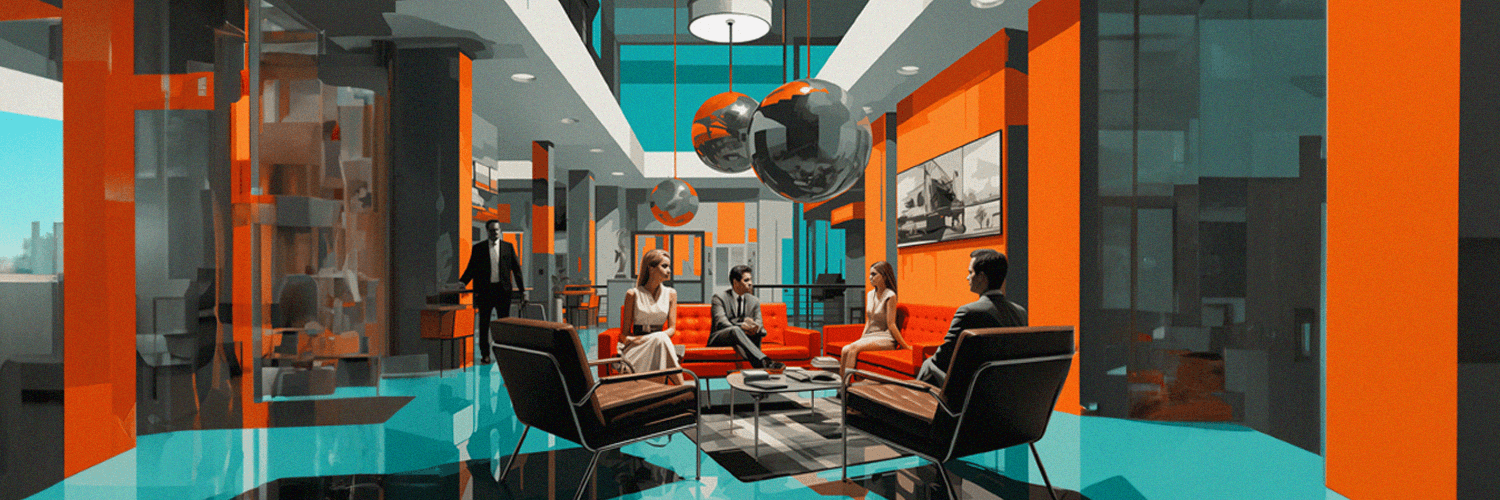As companies strive to create more engaging and satisfying work experiences for their employees, they're turning to workplace experience software. This innovative technology not only streamlines logistics and resource management, but also helps companies create a positive, sustainable workplace culture.
But what is it exactly, and what are the benefits of investing in such software?
TLDR:
- Workplace experience software represents a new wave of technology aimed at improving the quality of life for employees while increasing the operational efficiency of businesses.
- For IT, the software provides easy-to-use technology that integrates well with existing programs while ensuring user safety. It is designed to be user-friendly, reducing the need for technical support.
- HR departments also benefit significantly, as it improves employee satisfaction and well-being. Employees can easily manage their workspace preferences themselves, resulting in increased productivity.
- Facilities & Operations can optimize their costs by tracking space utilization using analytics provided by the software and implementing sustainable measures to reduce overhead costs.

What is Workplace Experience Software?
Workplace experience software is a comprehensive solution that helps organizations optimize their workspace, improve employee engagement and streamline operations. It brings together various elements, from resource scheduling to collaboration tools, into one easy-to-use platform.
At its core, the software aims to improve the overall employee experience by creating an environment that fosters creativity, productivity and well-being, and reducing time-consuming manual tasks such as booking meeting rooms or reserving office equipment through automated processes.
Transformation: From Resource Scheduling to Workplace Experience Software
In recent years, there has been a significant shift from traditional resource scheduling systems to workplace experience software. The modern workforce demands more than just a booking system for their desk and meeting rooms; they expect a seamless, engaging and customized experience.
This has led to the rise of workplace experience software, which allows companies to create an optimized work environment where communication channels are streamlined and access to information is effortless, resulting in an efficient yet enjoyable work culture where employees feel valued and motivated.
Workplace experience software integrates various technologies such as mobile apps, digital signage displays, or smart building systems to streamline HR management & Facilities Operations workflows while providing real-time insights on workplace utilization rates and occupancy trends.
The shift is driven by changing attitudes toward work-life balance and employee engagement. Employers recognize that creating an outstanding workplace increases productivity, improves collaboration between teams, and contributes to overall business growth.
Why Workplace Experience Software?
By combining various workplace management functions such as scheduling, reservation and maintenance on a single platform, workplace experience software is becoming an indispensable tool for businesses around the world.
The software makes it easier than ever for teams from different departments across the organization to work effectively towards common goals, leading to higher job satisfaction and better employee retention.
In addition, it can be used to optimize office space utilization and reduce real estate costs. Companies can track how workspace utilization changes over time and use that data to make informed decisions about future expansion or downsizing plans.

Benefits of Using Workplace Experience Software
Workplace experience software offers several benefits that make it an indispensable tool for any company. Here are some of them:
Benefits for IT teams
IT teams are the unsung heroes of every organization. They are responsible for maintaining and updating the technology infrastructure, ensuring data security and providing technical support to employees. Workplace experience software can greatly simplify their tasks and make them more efficient.
- One of the main concerns of IT teams is finding user-friendly technology that integrates well with existing systems. Workplace experience software solves this problem by integrating seamlessly with other applications such as calendar programs or communication tools.
- Workplace experience software can help with security and compliance, by providing secure integrations that protect sensitive information from unauthorized access. In addition, the software is typically compliant with various certifications, such as ISO, which ensure that the platform adheres to strict security protocols.
- Workplace experience software also offers real-time data analytics that enable IT teams to track usage patterns and identify trends to optimize scheduling processes or maintenance cycles. This helps reduce downtime and increase employee satisfaction.
Implementing workplace experience software can increase the productivity of IT teams by facilitating the coordination of system updates and improving the user experience through seamless integration with other platforms and security measures.
Benefits for HR
For HR, employee satisfaction and well-being are at the forefront of their priorities. With workplace experience software, HR can manage employee requests and concerns can be managed in one centralized location. This reduces the need for multiple systems or manual processes that can lead to errors and delays.
- Workplace experience software allows HR teams to gather insights on how employees are using office space and what amenities they prefer. By understanding these preferences, HR can make informed decisions about how to improve the overall workplace experience for employees.
- The software enables HR teams to create a more personalized approach for each individual employee. From booking desks based on personal preferences like lighting or temperature control, allowing them to reserve meeting rooms with ease or even ensuring that employees have access control over certain areas with secure workspaces; all contribute towards enhancing their well-being.
- Another great feature of work experience software is that it typically includes work scheduling features so that employees can schedule their own hybrid work arrangements (work from home, office, etc.). This increases employees' autonomy and their satisfaction with the workplace
By prioritizing employee satisfaction through advanced technology solutions like workplace experience software that streamlines processes while fostering a positive culture where everyone feels valued, a company can not only retain top talent, but also drive growth!
Benefits for Facilities & Operations
Facilities & Operations teams are concerned with all things optimization, especially when it comes to costs. With workplace experience software, these teams can optimize space, resources, and energy consumption.
- One key benefit is being able to reduce office space without impacting productivity or employee experience. The software offers features such as hot desking and desk hoteling which allows employees to book workspaces on demand, instead of having a dedicated desk that sits empty for hours every day.
- Another benefit is creating a sustainable workspace by leveraging data from workplace experience software solutions. This includes monitoring energy usage patterns across the organization and using the insights to identify areas where conservation efforts can be improved.
- Additionally, workplace experience software provides real-time analytics on how employees use spaces within an office building. These insights allow Facilities & Operations to adjust lighting and heating/cooling systems based on actual occupancy rates, instead of assumptions.
By automating tasks such as booking resources or checking visitors in and out with workplace experience software, Facilities & Operations teams save time and effort while improving accuracy through automation. This leads to cost savings that ultimately improve bottom-line performance.
Critical Features of Workplace Experience Platforms
Every successful system thrives on its vital components—the building blocks orchestrating perfection. Let's decode them!
Personalization Capabilities
Personalization capabilities strike as the first feature owing to their importance in fostering a sense of belonging among employees. People appreciate the uniqueness reflected within their working environment, whether font preferences or task management styles.
Analytics and Reporting Tools
These help organizations monitor progress toward established goals. They facilitate tracking productivity metrics or assessing employee satisfaction using interactive dashboards.
Integration with Existing Systems
A genuinely effective platform will smoothly integrate with existing systems, creating a seamless operational flow and saving time otherwise wasted navigating disparate systems.
Employee Engagement and Feedback Mechanisms
Active involvement stimulates intellectual investment while constructive feedback inspires growth and continuous improvement—some would argue these are two sides of one coin named 'Employee Satisfaction.'
Automation and AI Enhancements
Automation fosters efficiency while artificial intelligence drives smart decisions – advancements like these augment employees, empowering them rather than replacing them!
Use Cases of Workplace Experience Software
Workplace experience software increases employee satisfaction, productivity and well-being, and helps organizations optimize their workplace use. Here are some most popular use cases of workplace experience software solutions:
Downsizing Office Space
One of the most significant benefits of workplace experience software is that it allows organizations to downsize their office space. With more employees working remotely, they no longer need as much physical space as before.
Workplace experience software enables businesses to optimize their workspace usage and reduce costs associated with maintaining large offices. By using data analytics tools, they can determine which areas of the office are underutilized and consequently allocate those resources more efficiently.
In addition, downsizing office space can lead to a more sustainable workplace by reducing energy consumption and environmental impact. This is not only good for the environment, but also has a positive impact on a company's brand image.
Creating a Sustainable Workplace
As companies strive to reduce their carbon footprint and promote eco-friendliness, they are turning to workplace experience software as a powerful tool for creating sustainable workplaces.
- By utilizing features such as tracking and forecasting carbon emissions, these platforms provide organizations with the data needed to make informed decisions about reducing their environmental impact.
- In addition, many of these tools also incentivize employees to adopt more sustainable practices - from reducing their daily commute through remote work options to taking advantage of green transportation alternatives like biking or public transit.
- And, with all of the benefits that come with hybrid work (increased productivity, greater flexibility, and improved quality of life for employees) it's no wonder that sustainability-focused workplace experience software is becoming an essential part of modern business operations.
Improving Employee Experience
A positive employee experience can lead to higher productivity, greater job satisfaction and better employee retention. On the other hand, a negative employee experience can lead to absenteeism, poor morale and high turnover.
By allowing employees to book workstations at their convenience and personalize them according to their needs, they feel more comfortable in the workplace and are more motivated.
Workplace experience software can help optimize the employee experience by providing various tools – interactive floor maps, company-wide availability calendars, autonomous scheduling capabilities, and so on – that help employees feel connected to their colleagues, regardless of location or department.
Automating Workspace Booking
Automating workspace booking allows employees to quickly and easily book their workstations without having to overcome administrative hurdles or deal with manual processes.
With an automated system, employees can check availability and make reservations on the go via a mobile app or web interface. This not only saves time, but also reduces the risk of double-booking or other scheduling conflicts.
Moreover, automation helps organizations optimize their workspace usage by tracking occupancy patterns and identifying underutilized spaces. By understanding how their employees interact with the workspace, they can improve overall office design and layout, and even consider downsizing if necessary.
From HR 's perspective, automated workspace booking reinforces employee ownership by giving them more control over their workspace.
Boosting Human Resource and Facility Management Collaboration
By facilitating better communication and collaboration between human resources and facility management teams, workplace experience software helps ensure that employees have access to the right workspaces when they need them, which in turn boosts productivity.
Furthermore, workplace experience software makes it easier for HR and facilities teams to communicate with each other about issues related to workspace allocation or employee needs.
For example, HR can manage employee needs such as office space requests, while facilities managers can keep track of which spaces are available and how they're being used.
Making Data-Driven Decisions With Workplace Analytics
Workplace analytics provides data-driven insights into how workplaces are being used, which enables better decision making regarding resource allocation and optimization strategies.
- One key benefit of workplace analytics is its ability to provide real-time data on workspace utilization. This information can be used to understand how employees use different workspaces throughout the day, and identify underutilized spaces that could be repurposed or downsized.
- Analytics tools can also track metrics such as time spent at workstations, meeting attendance rates, and response times. This helps managers identify bottlenecks in workflow processes and determine areas where employees need additional training or support.
By collecting data from various sources such as sensors, mobile devices, and software applications, employers can understand which aspects of the workspace are most important to employees and tailor facilities management strategies accordingly.
Enabling Hot Desking or Desk Hoteling
Hot desking and desk hoteling enable flexible work arrangements that meet the needs of hybrid models. These solutions promote efficiency while meeting the needs of the modern workforce, such as flexible schedules and remote work arrangements.
- In a hot desking system, employees don't have assigned desks. Instead, they share workstations with other colleagues on a first-come, first-served basis. In this way, companies can not only reduce real estate costs, but also foster collaboration and cross-functional communication among team members who might not otherwise have come into contact with each other.
- Desk hoteling takes things one step further by allowing employees to reserve specific workstations in advance. This provides greater flexibility for remote workers or those who need to travel regularly, as they can book a workstation when they come into the office without worrying about finding an available space.
However, these systems do require some adjustments from both employees and management to ensure smooth operations. Effective communication is key to making sure everyone understands the rules of engagement regarding shared resources like printers or phone lines.

Implementing Hybrid Work Model
One of the benefits of workplace experience software is that it allows for a better work-life balance through hybrid work. In hybrid companies, employees can choose when to come into the office and when to work from home and plan their day to fit their personal life, which helps counter stress and burnout.
A significant benefit companies can gain from this approach is increased productivity. With the flexibility to work from home or the office, employees have more control over their work schedules, allowing them to make the most of their time and get more done.
In addition, a hybrid model allows companies to expand their talent pool across geographic boundaries. They can hire top-notch professionals from anywhere in the world who would otherwise be unable to relocate for full-time employment. This can significantly increase diversity within the company while improving employee morale and retention.
Another benefit is the cost savings for employers and employees alike. Companies no longer need as much space because fewer employees regularly work on-site, so they save on rental costs for large office spaces while still being able to provide occasional workspace for those who need it. For employees, there are savings in transportation costs and other expenses associated with commuting.
Ensuring Workplace Security & Compliance
Apart from boosting employee engagement and satisfaction rates, workplace experience software also offers several advantages for IT teams who prioritize secure, compliant and easy-to-use technology solutions that users will actually adopt.
Implementing robust security measures is crucial when it comes to adopting these technologies within the enterprise context; hence compliance must be ensured throughout all phases of deployment, so businesses can reap maximum benefits without compromising sensitive data or facing legal consequences.
Conclusion
As offices continue to move to hybrid work models, organizations need flexible technologies like workplace experience software that can quickly adapt to changing needs.
By providing employees with an integrated platform to book workspaces, access amenities, collaborate with colleagues and monitor their workplace well-being, workplace experience software transforms the traditional resource scheduling model into an immersive and engaging digital workspace.



.png)









